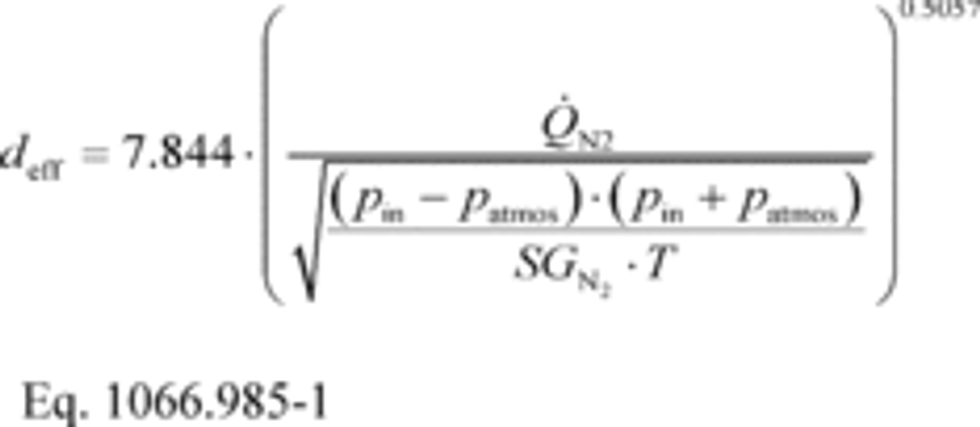['Air Programs']
['Air Emissions']
03/21/2023
...
(a) Scope. Perform this test as required in the standard-setting part to verify that there are no significant leaks in your fuel storage system.
(b) Measurement principles. Leaks are detected by measuring pressure, temperature, and flow to calculate an equivalent orifice diameter for the system. Use good engineering judgment to develop and implement leak test equipment. You may not tighten fittings or connections in the vehicle's fuel system to prepare the vehicle for testing.
(c) Measurement equipment. Your leak test equipment must meet the following requirements:
(1) Pressure, temperature, and flow sensors must be calibrated with NIST-traceable standards.
(2) Correct flow measurements to standard reference conditions.
(3) Leak test equipment must have the ability to pressurize fuel storage systems to at least 4.1 kPa and have an internal leak rate of less than 0.20 standard liters per minute.
(4) You must be able to attach the test equipment to the vehicle without permanent alteration of the fuel storage or evaporative emission control systems. For any testing that involves pressurizing the fuel system and detecting leaks at access points away from the fuel fill pipe, the gas cap must be installed in the production configuration. For the test point at or near the fuel fill pipe, attaching the test equipment may involve adding an extension to the fuel fill pipe that incorporates the access point to the fuel system. If the extension apparatus has a fixed cap, the vehicle's gas cap must be tested separately as described in paragraph (d)(9) of this section. This separate testing is not required if the extension apparatus incorporates the vehicle's gas cap.
(5) The point of attachment to the fuel storage system must allow pressurization to test system integrity of the fuel tank and of fuel lines and vapor lines reaching up to and including the gas cap and the evaporative canister. The evaporative system test port available on some vehicles is an example of an effective attachment point.
(d) Leak test procedure. Test a vehicle's fuel storage system for leaks as follows:
(1) Refuel vehicle to 40% of its nominal fuel tank capacity.
(2) Soak the vehicle for 6 to 24 hours at a temperature between (20 and 30)�C; record this setpoint temperature and maintain temperatures throughout the leak test at this setpoint temperature within a tolerance �2�C.
(3) Before performing the test, purge the fuel storage system of any residual pressure, bringing the system into equilibrium with ambient pressure.
(4) Seal the evaporative canister's vent to atmosphere and ensure that the vehicle's purge valve is closed.
(5) Attach the leak test equipment to the vehicle.
(6) Pressurize the fuel storage system with N2 or another inert gas 9392..........................to at least 2.4 kPa. Use good engineering judgment to avoid overpressurizing the system.
(7) Maintain gas flow through the system for at least 180 seconds, ensuring that the flow reading is stable for an effective leak diameter of �0.002 inches.
(8) Use the following equation, or a different equation you develop based on good engineering judgment, to calculate the effective leak diameter, deff:

Where:
deff = effective leak diameter, in inches, expressed to at least two decimal places.
Q ?/>N2= volumetric flow of nitrogen, in m 3/s.
pin = inlet pressure to orifice, in kPa.
patmos = atmospheric pressure, in kPa.
SGN2 = specific gravity of N2 relative to air at 101.325 kPa and 15.5�C = 0.967.
T = temperature of flowing medium, in K.
Example:
Q ?/>N2= 0.8�10?5 m 3/s
pin = 104.294 kPa
patmos = 101.332 kPa
SGN2 = 0.967
T = 298.15 K

deff = 0.017 inches
(9) Repeat the test described in this paragraph (d) for each access point described in the application for certification. Use each test result (without averaging) to determine whether the vehicle passes the leak standard.
(10) Gas caps may need to be tested separately for leaks as described in paragraph (c)(4) of this section. Test the gas caps using commercially available flow equipment such as that used for inspection-and-maintenance programs for motor vehicles to determine a leak rate in cubic centimeters per minute resulting from a sustained tank pressure of 7.5 kPa. Correct the leak rate to standard reference conditions, based on the measured leak rate corresponding to atmospheric pressure. The corrected leak value may not exceed 60 cubic centimeters per minute.
(11) You may use special or alternative test procedures as described in 40 CFR 1065.10(c).
(e) Equipment calibration. Use good engineering judgment to calibrate the leak check device.
[79 FR 23823, Apr. 28, 2014, as amended at 80 FR 9124, Feb. 19, 2015; 81 FR 74215, Oct. 25, 2016]
['Air Programs']
['Air Emissions']
UPGRADE TO CONTINUE READING
Load More
J. J. Keller is the trusted source for DOT / Transportation, OSHA / Workplace Safety, Human Resources, Construction Safety and Hazmat / Hazardous Materials regulation compliance products and services. J. J. Keller helps you increase safety awareness, reduce risk, follow best practices, improve safety training, and stay current with changing regulations.
Copyright 2025 J. J. Keller & Associate, Inc. For re-use options please contact copyright@jjkeller.com or call 800-558-5011.
